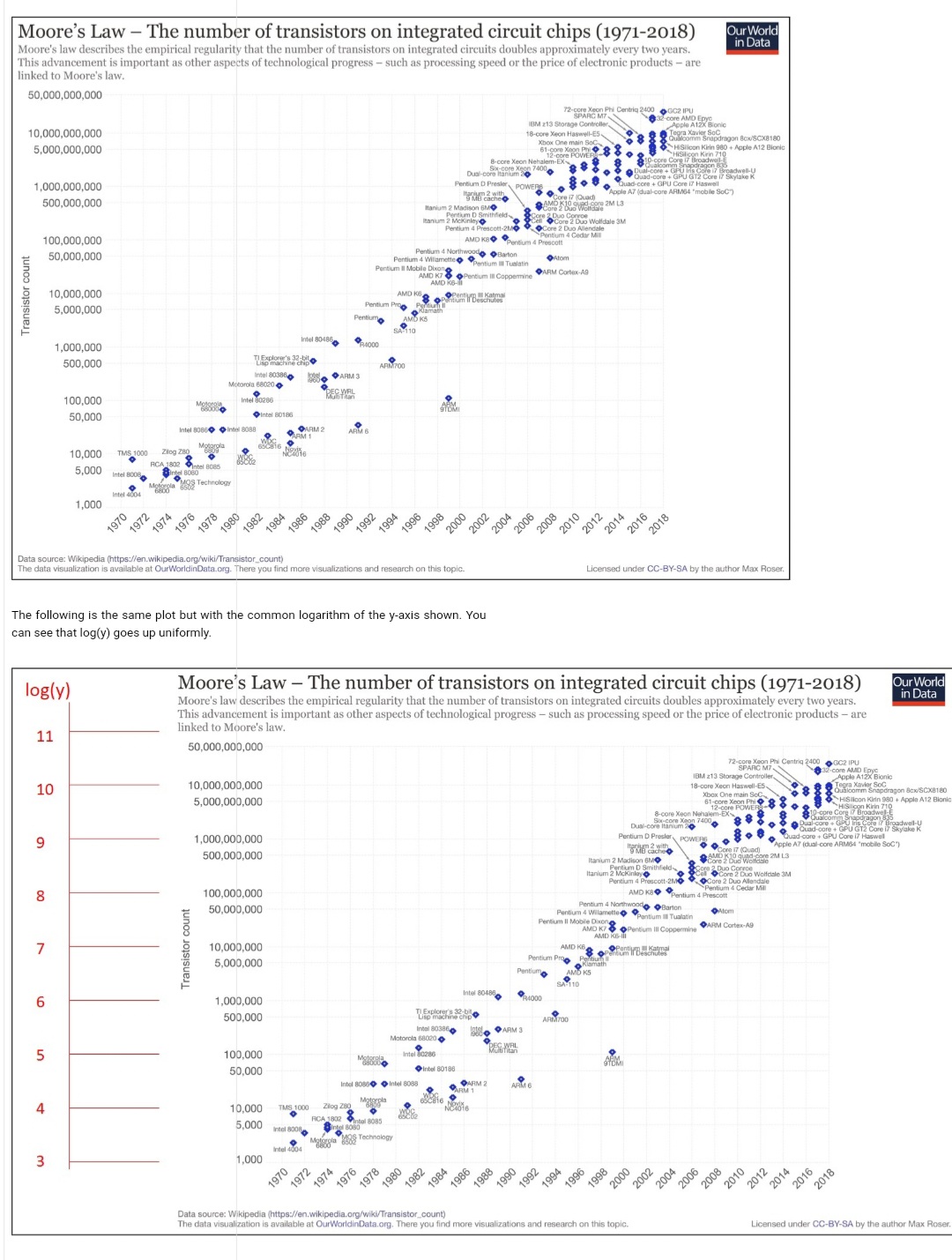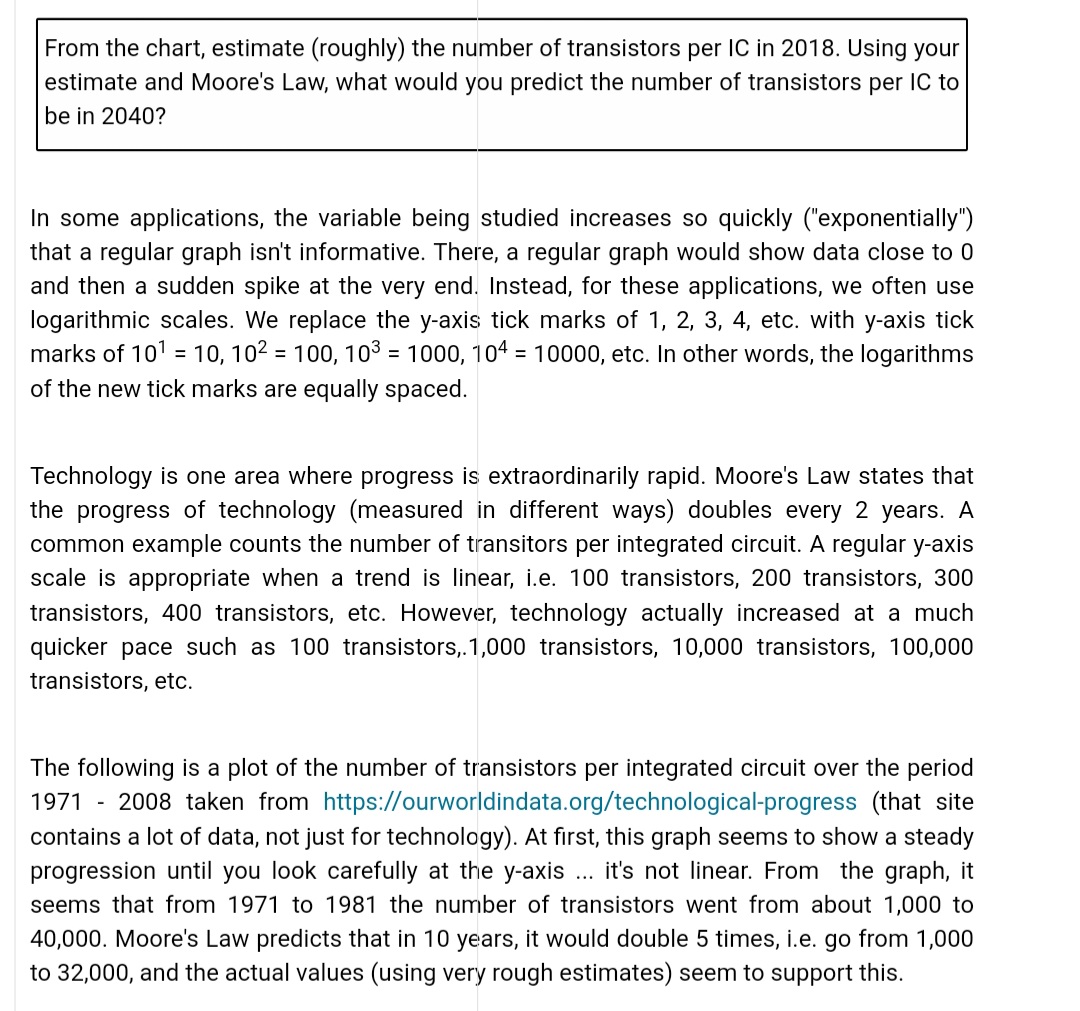Part a: The number of transistors per IC in 1972 seems to be about 4,000 (a rough estimate by eye). Using this estimate and Moore's Law, what would you predict the number of transistors per IC to be 20 years later, in 1992? Part b: From the chart, estimate (roughly) the number of transistors per IC in 2018. Using your estimate and Moore's Law, what would you predict the number of transistors per IC to be in 2040? Part c: Do you think that your prediction in Part b is believable? Why or why not?
Part a: The number of transistors per IC in 1972 seems to be about 4,000 (a rough estimate by eye). Using this estimate and Moore's Law, what would you predict the number of transistors per IC to be 20 years later, in 1992? Part b: From the chart, estimate (roughly) the number of transistors per IC in 2018. Using your estimate and Moore's Law, what would you predict the number of transistors per IC to be in 2040? Part c: Do you think that your prediction in Part b is believable? Why or why not?
Chapter10: Exponential And Logarithmic Functions
Section: Chapter Questions
Problem 442RE: Jerome invests $18,000 at age 17. He hopes the investments will be worth $30,000 when he turns 26....
Related questions
Question
Part a: The number of transistors per IC in 1972 seems to be about 4,000 (a rough estimate by eye). Using this estimate and Moore's Law, what would you predict the number of transistors per IC to be 20 years later, in 1992?
Part b: From the chart, estimate (roughly) the number of transistors per IC in 2018. Using your estimate and Moore's Law, what would you predict the number of transistors per IC to be in 2040?
Part c: Do you think that your prediction in Part b is believable? Why or why not?

Transcribed Image Text:Apple A12X Bionie
18-core Xeon Hawell-e
Moore's Law - The number of transistors on integrated circuit chips (1971-2018)
Moore's law describes the empirical regularity that the number of transistors on integrated circuits doubles approximately every two years.
This advancement is important as other aspects of technological progress - such as processing speed or the price of electronic products - are
linked to Moore's law.
Our World
in Data
50,000,000,000
72-core Xeon Phi Centriq 2400 0GC2 IPU
SPARC M7
10,000,000,000
IBM 213 Storage Controller
core AMD Epye
Apple A12XBonic
Tegra Xavier Soc
888 Ouloomm Snapdragon Bcw/SCXB180
5,000,000,000
Xbox One main
61-corm Xaon Ph 8 8.
HSlicon Kirin 980 + Apple A12 Bionic
B-core Xeon Nehalem-EXPOWER
Six-core Xeon 7400
Dual-core Itanlum 20
HISicon Krin 710
e spre Corg i7 Broadwel
De omm Sneadragon B35
OOaoreCM Coe 7 Broadwell
uad-core a GPU Core i Ha skylake k
1,000,000,000
Pentium D Presler POWERS
500,000,000
cache
"Apple A7 (dual-core
"mobile SoCn
RAMO KI0 oypd cop 2M L3
VCore 2 Duo Woltdale
core 2Duo Corvoe
9elCore 2 Duo Wolldale 3M
Pentium 4 Prescott-2MO Core 2 Duo Allendale
Itanium 2 Madison GMO
Pentkum D Smithfield
Itanium 2 McKinleyo
100,000,000
Pentium 4 Cedar Mil
AMD KBO O
Pentium 4 Northwoode OBarton
Pentium 4 Wiliamette ntium Tualatin
Pentium 4 Prescott
50,000,000
Otom
Pentium Mobile Dixone
AMD K7 6 OPentium i Copoemine ARM Cortex-Ag
10.000.000
AMD K6
OPentium Katmai
5,000,000
SA-10
1,000,000
intel 8048
000
500,000
TI Explore's 32-bil.
ARMP00
Intel 8030
Motorola 68020 o
. ARM 3
100,000
50,000
Ointel B016
Intel 8080O Ointel 8088
ARM
10,000
TMS 1000
Ziog Z80
6809
RCA 1802 ntel Bces
Bintel 8060
MOS Technology
5,000
Intel B00
Intel 4004
1,000
1978
1980
1970
Data source: Wikipedia (https://en.wikipedia.org/wiki/Transistor_count)
The data visualization is available at OurWorldinData.org. There you find more visualizations and research on this topic.
Licensed under CC-BY-SA by the author Max Roser.
The following is the same plot but with the common logarithm of the y-axis shown. You
can see that log(y) goes up uniformly.
log(y)
Moore's Law - The number of transistors on integrated circuit chips (1971-2018)
Our World
in Data
Moore's law describes the empirical regularity that the number of transistors on integrated circuits doubles approximately every two years.
This advancement is important as other aspects of technological progress – such as processing speed or the price of electronic products – are
linked to Moore's law.
11
50,000,000,00o
72-core Xeon Phi Centriq 2400 GC2 IPU
SPARC M7
10
10,000,000,000
-core AMD E
IBM z13 Storage Controller,
18-core Xeon Haswel-ES
Xbox One main Soc
61-core Xeon Phi O 8
12-core POWER
Tegra Xavlor SoC
Ouhicomm Snapdragon 8c/SCX8180
HISilicon Kirin 980 + Apple A12 Bionic
10ve CSicon Kirin 710
8R.cpre Corg Broadwe
O Dual core GU nE Core Broadwel-U
6 VQuad-core + GPU GT2 Core 17 Skyiake K
5,000,000,000
8-core Xeon Nehalem-EX
Sox-core Xeon 7400
Dual-core Itanium 20
9.
1,000,000,000
Pentium D Presler POWERE
• Ouad-core + GPU Core i7 Haswel
500,000,000
.re Quad
Apple A7 (dual-core ARMS4 "mobile SoC)
Itanium 2 Madison BMO
Pentium D Smithfield-
3MD KI0 ayad core 2M L3
Itanium 2 Mckinlayoed
C Core 2 Duo Wolfdale 3M
Pentium 4 Prescott-2MO OCore 2 Duo Allendale
Pentium 4 Cedar Mil
8
100,000,000
AMD K8O O
Pentium 4 Northwoode OBarton
Pentium 4 Wilamette entium Tualatin
Pentium 4 Prescott
50,000,000
Pentium II Mobile Dixone
AMD K7 OPentium ilI Coppermine
AMD KB-
OARM Cortex-A9
7
10,000,000
5,000,000
OPentium Katmai
. Oenum Il Deschutes
Pentium Proo
Pentiume
AMO KS
1,000,000
Intel 80486
R000
500,000
TI Explorer's 32-bi.
ARM00
Intel B03
Motorola 68020.
. PARM 3
100,000
Intel B0286
50,000
OIntel 80180
Intel 8080 o Intel 8088
OARM 2
RM 1
ARM 6
4
10,000
caie
5,000 vtel 800
Bntel Boso
Aglgla Technology
3
1,000
1970
1986
Data source: Wikipedia (https://en.wikipedia.org/wiki/Transistor_count)
The data visualization is available at OurWorldinData.org. There you find more visualizations and research on this topic.
Licensed under CC-BY-SA by the author Max Roser.
Transistor count
1972
1974
1976
1982
1984
1986
1988
1990
00
1992
1994
1996
1998
2000
2002
2004
2006
2008
Transistor count
2010
2012
2014
2016
2018
1972
1974
1976
1978
1980
1982
1984
1988
1990
1992
1994
1996
1998
2000
2002
2004
2006
2008
2010
2012
2014
2016
2018

Transcribed Image Text:From the chart, estimate (roughly) the number of transistors per IC in 2018. Using your
estimate and Moore's Law, what would you predict the number of transistors per IC to
be in 2040?
In some applications, the variable being studied increases so quickly ("exponentially")
that a regular graph isn't informative. There, a regular graph would show data close to 0
and then a sudden spike at the very end. Instead, for these applications, we often use
logarithmic scales. We replace the y-axis tick marks of 1, 2, 3, 4, etc. with y-axis tick
marks of 101 = 10, 102 = 100, 103 = 1000, 104 = 10000, etc. In other words, the logarithms
of the new tick marks are equally spaced.
%3D
Technology is one area where progress is extraordinarily rapid. Moore's Law states that
the progress of technology (measured in different ways) doubles every 2 years. A
common example counts the number of transitors per integrated circuit. A regular y-axis
scale is appropriate when a trend is linear, i.e. 100 transistors, 200 transistors, 300
transistors, 400 transistors, etc. However, technology actually increased at a much
quicker pace such as 100 transistors,.1,000 transistors, 10,000 transistors, 100,000
transistors, etc.
The following is a plot of the number of transistors per integrated circuit over the period
1971 - 2008 taken from https://ourworldindata.org/technological-progress (that site
contains a lot of data, not just for technology). At first, this graph seems to show a steady
progression until you look carefully at the y-axis . it's not linear. From the graph, it
...
seems that from 1971 to 1981 the number of transistors went from about 1,000 to
40,000. Moore's Law predicts that in 10 years, it would double 5 times, i.e. go from 1,000
to 32,000, and the actual values (using very rough estimates) seem to support this.
Expert Solution
This question has been solved!
Explore an expertly crafted, step-by-step solution for a thorough understanding of key concepts.
This is a popular solution!
Trending now
This is a popular solution!
Step by step
Solved in 3 steps

Knowledge Booster
Learn more about
Need a deep-dive on the concept behind this application? Look no further. Learn more about this topic, calculus and related others by exploring similar questions and additional content below.Recommended textbooks for you







College Algebra (MindTap Course List)
Algebra
ISBN:
9781305652231
Author:
R. David Gustafson, Jeff Hughes
Publisher:
Cengage Learning

Glencoe Algebra 1, Student Edition, 9780079039897…
Algebra
ISBN:
9780079039897
Author:
Carter
Publisher:
McGraw Hill

Trigonometry (MindTap Course List)
Trigonometry
ISBN:
9781337278461
Author:
Ron Larson
Publisher:
Cengage Learning